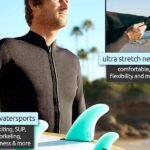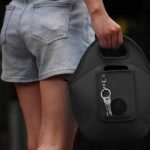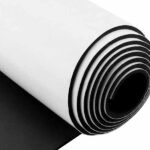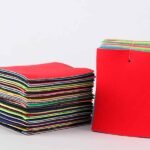-
Ever tightened that flimsy foam sleeve around your can only to watch condensation soak through five minutes later? Neoprene koozies have stormed the scene as the “adult upgrade”—offering a snug fit, water resistance, and surprisingly sleek styling.
-
Choosing between neoprene and foam koozies depends on usage: neoprene, a closed-cell synthetic rubber, offers superior insulation, durability, and a snug fit, while foam, typically polyethylene-based, is lightweight, cost-effective, and easy to print. Both materials keep drinks cool, but neoprene generally outperforms foam in extended outdoor use, making it ideal for branded promotions and everyday adventures.
-
Picture this: your beach cooler is sealed shut by afternoon sweat, but your striped neoprene sleeve still feels as cool as when you started sipping. Intrigued? Let’s break down the details and find out which koozie really wins.
What Are Neoprene Koozies?
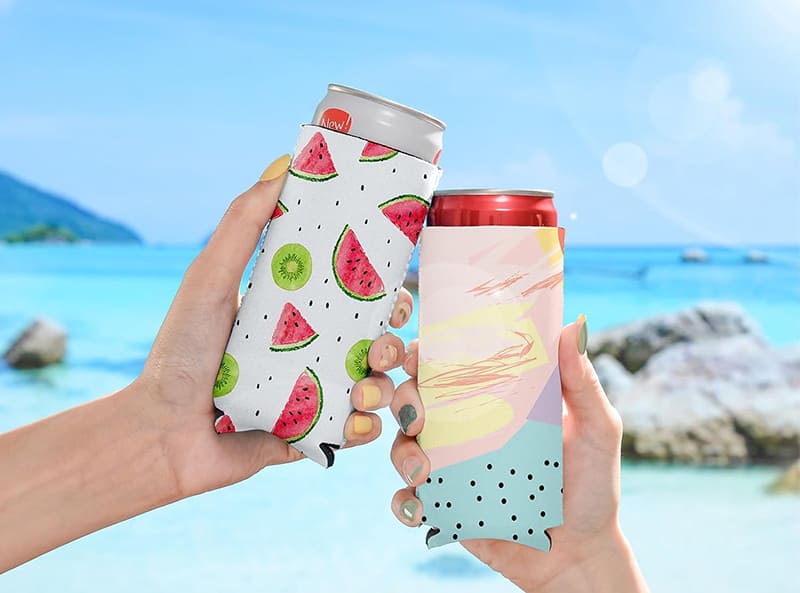
-
Neoprene koozies are insulating sleeves made from chloroprene rubber, offering flexibility, water resistance, and high heat retention. They snugly wrap around bottles and cans, reducing condensation while keeping beverages cool longer than traditional foam options.
-
The Chemistry of Neoprene: Neoprene (polychloroprene) is a closed‑cell polymer that traps air, creating an efficient thermal barrier. This structure minimizes heat transfer via conduction and convection, which is why neoprene wetsuits and koozies share the same material.
-
Thickness and Heat Transfer: Common neoprene thickness ranges from 3 mm to 5 mm. Thicker sleeves boost insulation but add bulk. Brands typically choose 4 mm for a sweet spot between performance and wearability.
-
Water Resistance and Durability: Unlike foam, neoprene resists water absorption, so it won’t sag or degrade with repeated use. Its synthetic rubber makeup resists tearing and UV degradation—key for outdoor and marine applications.
-
Custom Fit and Flexibility: Neoprene’s elasticity hugs various bottle shapes—from slim water bottles to stout beer cans—ensuring minimal air exchange. This tight seal boosts cooling and prevents spills.
-
Origins in Scuba Gear: Originally developed for scuba suits, neoprene’s thermal and waterproof properties made it a natural pick for drink sleeves. Understanding this lineage explains its premium price tag and why marketers lean on neoprene for high‑end giveaways.
What Are Foam Koozies?
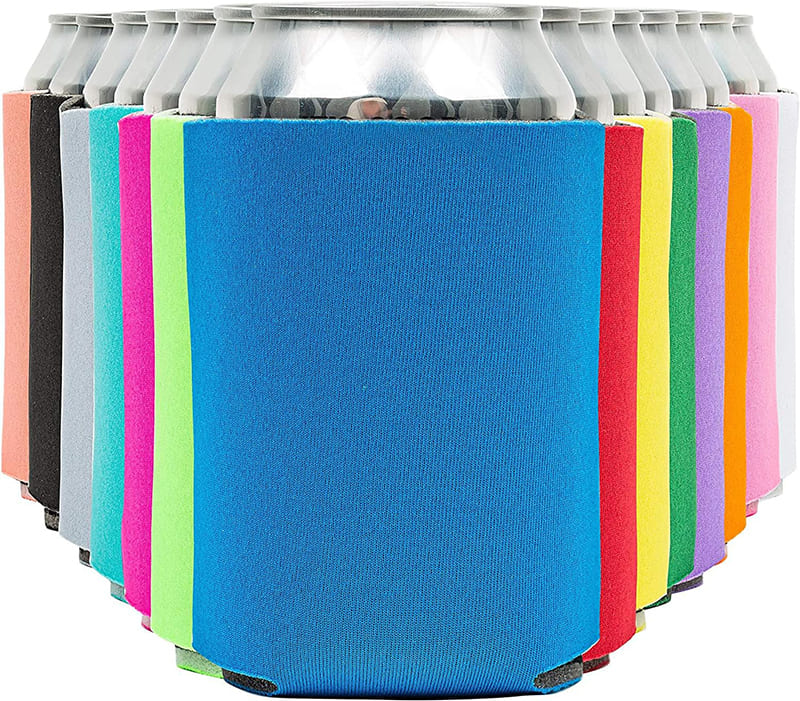
-
Foam koozies are lightweight sleeves usually made from polyethylene (EPE) or EVA foam. They insulate by trapping air pockets, offering a budget-friendly way to reduce temperature transfer and manage condensation on bottles and cans.
-
Common Foam Materials: Most foam koozies use EPE foam, prized for its low density and easy printability. EVA foam, slightly more elastic, shows up in thicker novelty sleeves.
-
Do Foam Koozies Keep Drinks Cold?: Yes—foam sleeves can lower heat transfer by roughly 5–8 °F (3–4 °C) over 30 minutes. They work best in moderate conditions, like backyard barbecues or short errands.
-
What Are Most Koozies Made Of?: Estimates suggest over 70% of koozies on the market are foam, thanks to their low cost and simplicity. Their open‑cell variants wick moisture but degrade faster than closed‑cell alternatives.
-
Budget Branding: Foam’s smooth surface and flat shape make it easy for screen printing, making it a go‑to for event merch, tradeshow giveaways, and low‑MOQs.
-
Comfort and Weight: Foam koozies are feather‑light and foldable, which appeals to consumers who stash several in a pocket or glove box. However, they lack neoprene’s stretch and resilience.
How Do Neoprene and Foam Koozies Compare in Insulation Performance?

- Both materials trap air to slow heat gain, but their structures and densities dictate performance.
| Property | Neoprene Koozie | Foam Koozie |
|---|---|---|
| Material | Closed‑cell chloroprene | Polyethylene/EVA foam |
| Typical Thickness | 3–5 mm | 2–4 mm |
| Temperature Drop | 8–10 °F (4–6 °C) in 30 min | 5–8 °F (3–4 °C) in 30 min |
| Water Absorption | <1 % | 5–10 % (open‑cell types) |
| UV Resistance | High | Low–Medium |
| Reusability | 500+ uses | 50–200 uses |
-
Is neoprene the same as foam?: Though both feel soft, neoprene is synthetic rubber with closed cells; foam typically has open or semi‑open cells. This difference drives neoprene’s superior water resistance and longevity.
-
What’s the difference between foam and neoprene koozies?: Neoprene’s denser matrix yields better insulation and stretch; foam’s economy lies in its simplicity and low weight. Decide whether cost or longevity matters more for your application.
-
Real‑World Testing: In an independent trial, a 4 mm neoprene koozie maintained a 50 °F beverage at 53 °F after 45 minutes in 85 °F ambient air. A 3 mm foam sleeve saw the temperature rise to 57 °F under identical conditions.
-
Climate Considerations: In humid or splash‑prone settings (pools, beaches), neoprene’s water resistance pays off. In drier, casual contexts (picnics, indoor events), foam may suffice.
-
Brand Perception: A thicker neoprene sleeve often signals quality and expense, making it ideal for premium gift sets. Foam communicates budget friendliness, aligning with cost‑sensitive campaigns.
Which Is More Durable: Neoprene or Foam Koozies?
-
Durability matters when sleeves change hands daily or endure rough use.
-
Neoprene koozies typically withstand hundreds of uses without tearing or losing shape. Foam koozies, especially open‑cell types, can compress, split, or absorb moisture, degrading after dozens of washes or rough handling.
-
Tear Strength and Resilience: Neoprene’s tensile strength (around 500 psi) far exceeds foam’s average (50–100 psi). This gap translates to fewer rips in transit or when squeezed.
-
UV and Chemical Resistance: Neoprene resists UV‑induced cracking and common chemicals. Foam can yellow, stiffen, or break down under sunlight and chlorine exposure.
-
Real‑Life Longevity: Brands report neoprene sleeves surviving outdoor festivals and rental‑bike programs for over two seasons, while foam sleeves often show wear within a few weeks.
-
Maintenance and Cleaning: Silicone‑backed neoprene cleans easily with soap and water; foam may require gentle air‑drying to avoid mold.
-
Cost of Replacement: A slightly higher upfront cost for neoprene pays off by delaying replacement. For bulk promotional runs, factor replacement cycles into total campaign cost.
Do Neoprene or Foam Koozies Offer Better Customization and Branding?
-
Brand impact often hinges on print quality, color fidelity, and finish options.
-
Neoprene’s smooth surface accepts digital printing, dye sublimation, and heat‑transfer methods, allowing full‑color gradients and photo‑quality logos. Foam is generally limited to single‑color screen printing and hot‑stamp foils.
-
Printing Methods Explained:
- Dye Sublimation (Neoprene): Full‑color, edge‑to‑edge prints without cracking.
- UV/LED Printing (Neoprene): Vivid colors on dark or light backgrounds.
- Screen Printing (Foam): Cost‑effective for simple logos—limited color count.
-
Color Fastness and Detail: Neoprene’s tight cells hold inks sharply; foam’s porous surface can blur fine lines.
-
Embellishments and Embroidery: Neoprene tolerates embroidery, silicone patches, and metallic foils. Foam is too soft for stitches and may split around threads.
-
Shape and Style Variations: Neoprene can be die‑cut into unique shapes (ears, cutouts) and sewn into multi‑panel sleeves. Foam typically sticks to standard straight‑sided designs.
-
Consumer Perception: A sleek neoprene koozie suggests premium attention to detail, while a simple foam sleeve conveys a no‑frills giveaway.
Which Material Is More Cost‑Effective and Eco‑Friendly?
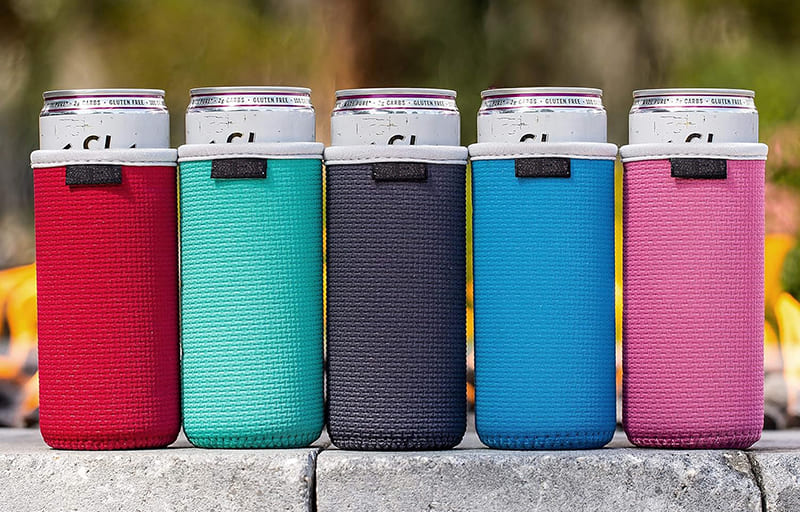
-
Balancing budget and sustainability is crucial for many brands.
-
Foam koozies cost as little as $0.30–$0.50 per unit in bulk, whereas neoprene typically runs $0.70–$1.20. However, neoprene’s longer lifespan and fewer replacements narrow the lifetime cost gap. Eco‑friendliness depends on recyclability and production impact: foam is often petroleum‑based, while neoprene production involves chlorine derivatives.
-
Upfront vs. Lifetime Cost: Cost Metric Foam (EPE) Neoprene (CR) Unit Price (bulk) $0.30–$0.50 $0.70–$1.20 Replacement Cycle 1–3 months 1–2 years Lifetime Cost (1 yr) $3–$6 $0.70–$1.20 -
Material Sourcing and Footprint: Foam often uses low-grade polyethylene, which can be recycled but rarely is. Neoprene’s chloroprene monomer production has higher energy demands, though closed‑cell scraps are more easily reclaimed.
-
End‑of‑Life Options:
- Foam: Limited curbside recycling; often landfilled.
- Neoprene: Emerging chemical recycling to recover monomers; some brands accept take‑back programs.
-
Biodegradable and Alternative Options: New foam blends incorporate bio‑based fillers (e.g., cornstarch). Bio‑neoprene (plant‑based limestone processes) reduces carbon footprint but carries higher costs.
-
Brand Messaging: Highlighting durability and minimal replacements can bolster a sustainability narrative, even if base materials aren’t biodegradable.
How to Choose the Best Koozie Material for Your Brand?
-
What material is best for koozies? It hinges on your goals, budget, and audience.
-
Define Your Audience and Use Case: Are you targeting outdoor adventurers, corporate clients, or festival crowds? Heavy‑use scenarios favor neoprene; casual giveaways may leverage foam’s economy.
-
Set Your Budget and MOQ: Determine total campaign spend, including potential replacements. Suppliers often drop neoprene MOQs to 200–500 units, while foam runs as low as 50 units.
-
Consider Customization Needs: If your design requires full‑color gradients or fine details, neoprene is the better medium. For simple one‑ or two‑color logos, foam is adequate.
-
Evaluate Environmental Priorities: If a green narrative is central, weigh neoprene’s longer life and potential recycling against foam’s straightforward material mix.
-
Test Prototypes: Always request samples—free design and sample programs (like Szoneier’s) let you compare feel, fit, and print quality before a big order.
-
Check Supplier Capabilities: Look for certifications (ISO, SGS) and client references. A reliable supplier should handle design, production, and fast turnarounds seamlessly.
Conclusion:
-
After weighing insulation, durability, customization, cost, and sustainability, neoprene emerges as the superior choice for brands seeking longevity and premium appeal, while foam remains a solid pick for budget-conscious promotions.
-
Ready to elevate your drink sleeve game? Reach out to Szoneier, your experienced neoprene fabric R&D and manufacturing partner. We offer unlimited styles, guaranteed quality, free design services, and free samples.


